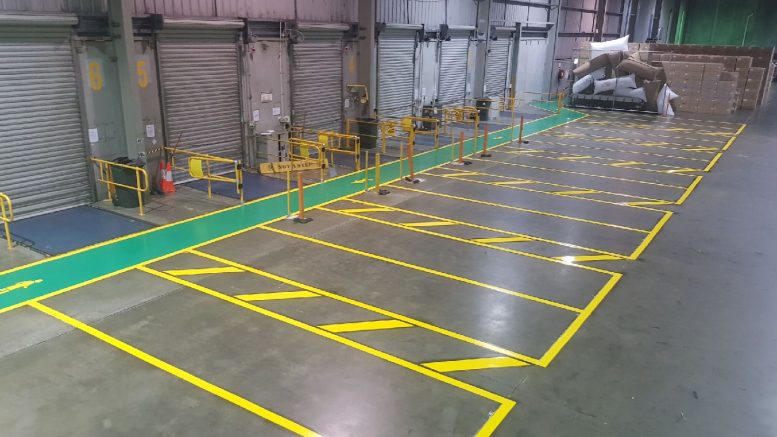Any company that depends on storage, warehousing and distribution will understand that warehouse linemarking is vital to the efficient operation of their business. Whilst most people are used to seeing linemarking on roads and in car parks, their use in warehouses goes far beyond a safety factor.
Safety of course, is the prime reason for linemarking in warehouses, but increased productivity, optimal space allocation, standards compliance, and increased workplace health and safety, are also positive results of professional warehouse linemarking.
1. Employee safety
Boxes stacked haphazardly, forklifts zipping around seemingly at random, and workers walking under hoists are all accidents waiting to happen. Employee safety is a vital component of any business, but when trucks, forklifts and employees need to operate in the same confined space and without some sort of organisation, safety is more of a hope than a foregone conclusion. This is where warehouse linemarking steps into the breach, because it clearly defines how employees, forklifts and trucks can and cannot navigate throughout the warehouse.
2. Increased productivity
Chaos doesn’t equate with efficiency, which is why an organised and efficient working environment is good for business. If employees have to search for the right pallets or boxes, dodging forklifts as they try to navigate through a disorganised warehouse, time is wasted and efficiency non-existent. On the other hand, when everything is in its rightful place and in clearly defined areas, employees can quickly locate the pallets or boxes they need to fulfill an order (whilst not needing to dodge wayward forklifts). In this case, warehouse line marking helps to make operations run much more smoothly, maximising productivity and minimising wasted time.
3. Optimal space allocation
It’s a foregone conclusion that if you can maximise the storage capacity of your warehouse, you can also maximise your profits; the more you store, pack and distribute, the greater your revenue. Warehouse linemarking forces you to store pallets and boxes in designated bays, allowing you to easily identify available space, freeing up space and highlighting storage issues. When everything is jumbled around and stored haphazardly, it’s never clear how much free space you actually have in a warehouse; with a regimented structure of marked bays however, it’s easy to decide whether disorganisation or a lack of space was the problem.
4. Standards compliance
An organised warehouse with clearly designated stacking bays, well-defined forklift lanes, and hazards clearly identified, goes a long way to complying with Australian safety standards. These include standards for steel storage racking (AS4084:2012) and planning for emergencies in facilities (AS3745:2010), as well as a variety of relevant Codes of Practice (airborne contaminants, managing noise, working in confined spaces, etc.). Business that pay attention to operating a safe and efficient working environment, not only increase their revenue, but they usually have no problems with compliance.
5. Workplace health and safety
Compliance with the Work Health and Safety Act 2011 is made much easier when the working environment is organised and efficient. The health, safety and welfare of employees, contractors, subcontractors and visitors are all ensured under the Act, by either minimising or eliminating onsite risks. Compliance leads to fewer accidents, reduced Workers Compensation claims, and a safe working environment, all of which is underpinned by the safety and organisation provided by professional warehouse linemarking.



Be the first to comment on "The importance of warehouse linemarking"